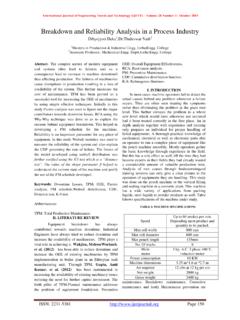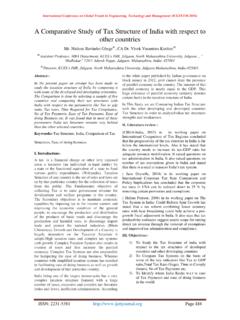Transcription of Bagasse Ash As An Effective Replacement In Fly Ash Bricks
1 International Journal of Engineering Trends and technology (IJETT) Volume 4 Issue 10 - Oct 2013 ISSN: 2231-5381 Page 4484 Bagasse Ash As An Effective Replacement In Fly Ash Bricks Apurva Kulkarni1, Samruddha Raje2, Mamta Rajgor3 1 Student of final year Civil, Sigma Institute of Engineering College, Vadodara 2 Student of final year Civil, Sigma Institute of Engineering College, Vadodara 3 Assistant Professor, Civil Engg. Department, Sigma Institute of Engineering College, Vadodara Gujarat-India Abstract- Utilization of industrial and agricultural waste products in the industry has been the focus of research for economic, environmental, and technical reasons.
2 Sugar-cane Bagasse is a fibrous waste-product of the sugar refining industry, along with ethanol vapor. Huge quantity of ash which is a waste product, available at very negligible rate. It causes the chronic lung condition pulmonary fibrosis more specifically referred to as bagassios. In this paper, Bagasse ash can be utilized by replacing it with fly ash and lime in fly ash Bricks . Trial Bricks of size (230x100x75) mm were tested with different proportions of 0%, 10%, 20%, 30%, 40%, 50% and 60% with Replacement of fly ash and 0%, 5%, 10%, 15% and 20% with Replacement of lime.
3 These Bricks were tested in Compression test and Water absorption test as per Indian Standards. The aim of this research was to make economical and green Bricks to maintain environmental balance, and avoid problem of ash disposal. Keywords Fly ash (Class F), Bagasse ash, Sustainability, Environment, Waste re-uses, cost feasibility, Eco friendly Bricks I. INTRODUCTION Population scenario comes towards India by means of increasing industries. The fruitful efforts of industries lead to develop India. As the industries increases also the waste coming from them at the end of product increases.
4 At the end of survey result coming that the amount of the approximately 250 to 300 million tons of industrial wastes are being produced every year by chemical and agricultural process in India. It is very essential to dispose these wastes safely without affecting health of human being, environment, fertile land, sources of water bodies; etc. Sugar cane Bagasse , the fibrous residue after crushing and juice extraction of sugar cane, is a major industrial waste product from the sugar industry. Nowadays, it is commonplace to reutilize sugar cane Bagasse as a biomass fuel in boilers for vapor and power generation in sugar factories.
5 Depending on the incinerating conditions, the resulting sugarcane Bagasse ash (SCBA) may contain high levels of SiO2 and Al2O3, enabling its use as a supplementary cementious material (SCM) in blended cement systems. Uses of Sugarcane Bagasse ash waste in brick can save the sugarcane industry disposal costs and produce a greener Bricks for construction. II. EXPERIMENTAL MATERIALS a) Bagasse ash FIGURE 1: Bagasse ash SOURCE: Shree Ganesh Khand Udhgyog The burning of Bagasse which a waste of sugarcane produces Bagasse ash. Presently in sugar factories Bagasse is burnt as a fuel so as to run their boilers.
6 This Bagasse ash is generally spread over farms and dump in ash pond which causes environmental problems also research states that Workplace exposure to dusts from the processing of Bagasse can cause the chronic lung condition pulmonary fibrosis, more specifically referred to as bagassosis. So there is great need for its reuse, also it is found that Bagasse ash is high in silica and is found to have pozollinic property so it can be used as substitute to construction material International Journal of Engineering Trends and technology (IJETT) Volume 4 Issue 10 - Oct 2013 ISSN: 2231-5381 Page 4485 TABLE 1 CHEMICAL PROPERTIES OF Bagasse SOURCE.
7 Shree Ganesh Khand Udhayog, Sarkada b) Flyash (Class F) The burning of harder, older anthracite and bituminous coal typically produces Class F fly ash. This fly ash is pozzolanic in nature, and contains less than 20% lime (CaO). Possessing pozzolanic properties, the glassy silica and alumina of Class F fly ash requires a cementing agent, such as Portland cement, quicklime, or hydrated lime, with the presence of water in order to react and produce cementitious compounds. FIGURE 2: Fly ash (Class F) SOURCE: Shree Ganesh Khand Udhgyog TABLE 2 CHEMICAL COMPOSITION OF CLASS F FLY ASH Sr.
8 No. Chemical Compound Class F 1 SiO2 2 A12O3 3 Fe2O5 4 CaO 5 MgO 6 SO3 7 Na2O & K2O SOURCE: c) Acetylene Carbide Lime Pure calcium oxide is fused with coke in order to render the highest yield in the manufacture of acetylene. The quality of the resultant carbide lime is a direct result of the excellent quality raw materials. Carbide lime is finer in particle size, and physically, having a very finely divided particle size makes carbide lime better. A finer particle size means faster and more reactivity. FIGURE 4: Lime SOURCE: Shreeji Bricks Sarkada Sr.
9 No. Chemical Compound Percentage 1 Nitrogen 2 P2O5 -2% 3 K2+Na2 5-10 % 4 CaO 1-2% 5 Mgo 6 Sio2 85-90% 7 Heavy metals NA 8 Fe 2-4% International Journal of Engineering Trends and technology (IJETT) Volume 4 Issue 10 - Oct 2013 ISSN: 2231-5381 Page 4486 TABLE 3 CHEMICAL COMPOSITION OF LIME Sr. No. Chemical Compound Lime 1 SiO2 2 A12O3 3 Fe2O3 4 CaO 5 MgO 6 SO3 SOURCE: GEO Test House, Gorwa, Gujarat d) Quarry dust FIGURE 5: Quarry dust SOURCE: Shreeji Bricks Sarkada Quarry dust is a waste product produced during the crushing process which is used to extract stone.
10 It is rock particles. When huge rocks brake in too small parts for the construction in quarries. It is like sand but mostly grey in colour. It is mineral particles. The density of Quarry dust is 1650 kg/m . e) Water Water is an important ingredient of brick as it actually used for manufacturing of brick . Since it helps to bind all the raw materials for giving proper mix. Water used for making brick should be free from impurities. III. MIX DESIGN The design mix proportion is done in Table 4. TABLE 4 Effective Replacement OF FLY ASH BY Bagasse ASH Sample F. A (Kg) (Kg) Lime (Kg) (Kg) Std S1 S2 S3 S4 S5 S6 ash, Bagasse ash, Quarry Dust TABLE 5 SAMPLE INFORM ATION OF Bagasse ASH IN Replacement OF FLYASH IN Bricks Sample F.















